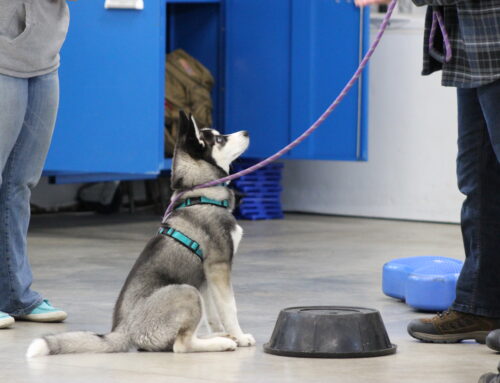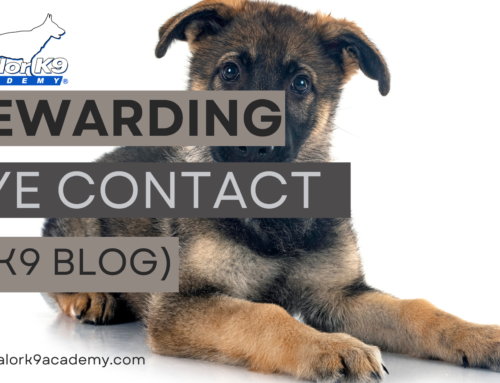There are so many benefits of e-collar training and so many dogs lives have been saved because of it. I think the e-collar is a fantastic training tool especially for off leash training. But I didn’t always think that way.

My first introduction to the e-collar was at dog training school. The instructor asked for a student to volunteer their dog so he could demonstrate how to properly fit and use the e-collar in training recall. I volunteered my dog, Zoey, fully trusting that he would do right by her. What I witnessed over the next few minutes crushed me. Zoey is a very sensitive dog. She doesn’t need much by way of corrections and does best when training is positive and upbeat. She’s smart and can be stubborn with a bit of attitude at times, but she isn’t a ‘hard’ dog by any means. When the instructor fitted her for the collar, she immediately froze up. I’ve never used anything more than a martingale collar on Zoey; she simply doesn’t need more than that. Feeling the tightness of the e-collar startled her and made her feel like she was being corrected. She panicked and ran towards me with the most frightened expression. Trusting the instructor, I told her to “go back” to him and he continued with training. For the next 5 minutes, he corrected her over and over with increasing levels of stimulation because she was ignoring him. She had completely shut down and was refusing to move. The instructor continued correcting her then gave up and gave her back to me; she wanted nothing to do with him and was shaking like a leaf.
At that moment, I decided that I hated e-collars and for the next year I refused to use them in training. I had had such a negative experience with it that I didn’t see why using one would be necessary. Then I started following other trainers that I looked up to and respected, and I saw that a lot of them use e-collars. I was surprised because in my mind, no good could come from “shocking” a dog. That’s when I started to research e-collars more, and I realized that the instructor who worked with Zoey should’ve immediately recognized that because of her personality type, previous history of abuse and sensitivity to corrections she was not a candidate for e-collar training. No two dogs are alike; what works beautifully for one dog may not work for another dog. Good trainers know that, and they’re experienced enough to meet a dog and know almost instantly what will and won’t work for that dog.
will and won’t work for that dog.
After hours of researching and speaking with other professional trainers, I learned how to use the e-collar correctly and was able to apply my newfound knowledge first to my personal dogs and then to dogs in training with me. Even so, last year I only used the e-collar on a handful of dogs and only when the owner specifically requested it and if it was appropriate for the dog. There are a lot of misconceptions on e-collar training so let’s delve right into that with FAQs:
Q: Will the e-collar hurt my dog?
A: When used properly, an e-collar will not hurt your dog. It’s an inanimate object and, as such, it’s subject to user skill and judgment. Most dogs respond to e-collar training on the lowest level of stimulation which is hardly recognizable by humans. Good training uses low levels of stimulation which result most often in a head tilt from the dog. They know they felt something, and it was enough to get their attention, but it didn’t shock them or result in vocalization of any degree. Can an e-collar hurt a dog? Absolutely. Like anything, an e-collar is a training tool which means that in the wrong hands it can be abused. An e-collar is no different from a leash in terms of use and potential for abuse. The individual holding the leash – or the remote – is responsible for proper training and conditioning. It’s always best to consult a professional to begin e-training.
Q: Does the collar shock the dog?
A: E-collars, also called shock collars or electronic collars, apply a negative stimulus through the use of static correction which surprises but does not hurt the dog.
Q: Why are positive-only trainers against the use of e-collars?
A: Most positive-only trainers eschew the use of e-collars, claiming they’re abusive, that e-collar trainers “shock the hell out of dogs.” Are there trainers out there that use e-collars to shock the hell out of dogs? Absolutely. I’ve worked with dogs that have been nearly ruined by those trainers. Dogs that are afraid of the collar and run away at the sight of the remote. But saying that all trainers who use e-collars shock the hell out of dogs is absolutely ridiculous.
E-collar training is not a shortcut to good training. It’s a safety measure that protects dogs and gives a feeling of comfort to owners who have invested the time into training and want to trust their dogs off leash but also want to be able to get their dogs’ attention if necessary.
For example, in teaching a dog to come when called I first start with positive reinforcement reward-based training. We put the dog on a slip lead and use treats to help create a positive association between the recall command (“Come”) and the behavior of coming when called. After hundreds of repetitions over 1-2 weeks’ time, we generalize the behavior both indoors, outdoors and in new environments then we add a long line and add distractions in a controlled environment. After 2-3 weeks of training, the dog is happily coming when called anytime anyplace on both a regular leash and long line. When we feel the dog is ready, we layer the long line with the e-collar. I use the “tone” feature on the e-collar paired with the recall command and a treat reward to teach the dog to come when called at the push of a button. No correction needed. Increase the distractions in training and when the time comes, and it will, that the dog chooses to disobey the recall command, I give a low level correction and repeat the recall command. The dog then learns how to ‘turn off’ the correction by coming when called. Once that’s clear, the leash comes off and voila, your dog now comes when called off leash.

My clients have used e-collar training to recall their dog away from cats, deer, squirrels, skunks and more. Other clients use e-collar training to correct excessive barking, chewing and digging when other training methods simply don’t work. There’s only so much you can do with a clicker and treats if your dog goes nuts when a squirrel is outside hopping from tree to tree.
Q: How do I know if e-collar training is right for my dog?
A: I recommend consulting an experienced professional trainer to find out if e-collar training is appropriate for your dog. I refuse to do e-collar training with a lot of clients who think it’s a good quick fix; it’s not. Put the time into training and then use the e-collar when appropriate for certain situations and training objectives.
I hope you’ve enjoyed this article – please share it with your friends!
Amy Pishner is Owner of Valor K9 Academy and the Head Trainer for VK9-Spokane. She ranks among the highest accredited trainers nationally and is a trusted American Kennel Club (AKC) Canine Good Citizen evaluator and a proud member of the (IACP) International Association of Canine Professionals.








Leave A Comment